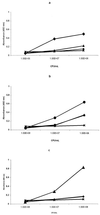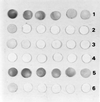Identification and strain differentiation of Vibrio cholerae by using polyclonal antibodies against outer membrane proteins
- PMID: 11427424
- PMCID: PMC96140
- DOI: 10.1128/CDLI.8.4.768-771.2001
Identification and strain differentiation of Vibrio cholerae by using polyclonal antibodies against outer membrane proteins
Abstract
Cholera is caused only by O1 and O139 Vibrio cholerae strains. For diagnosis, 3 working days are needed for bacterial isolation from human feces and for biochemical characterization. Here we describe the purification of bacterial outer membrane proteins (OMP) from V. cholerae O1 Ogawa, O1 Inaba, and O139 strains, as well as the production of specific antisera and their use for fecal Vibrio antigen detection. Anti-OMP antisera showed very high reactivity and specificity by enzyme-linked immunosorbent assay (ELISA) and dot-ELISA. An inmunodiagnostic assay for V. cholerae detection was developed; this assay avoids preenrichment and costly equipment and can be used for epidemiological surveillance and clinical diagnosis of cases, considering that prompt and specific identification of bacteria is mandatory in cholera.
Figures



Similar articles
-
Differentiation among the Vibrio cholerae serotypes O1, O139, O141 and non-O1, non-O139, non-O141 using specific monoclonal antibodies with dot blotting.J Microbiol Methods. 2011 Nov;87(2):224-33. doi: 10.1016/j.mimet.2011.07.022. Epub 2011 Aug 6. J Microbiol Methods. 2011. PMID: 21851839
-
Identification of some antigenically related outer-membrane proteins of strains of Vibrio cholerae O1 and non-O1 serovars involved in intestinal adhesion and the protective role of antibodies to them.J Med Microbiol. 1989 May;29(1):33-9. doi: 10.1099/00222615-29-1-33. J Med Microbiol. 1989. PMID: 2724325
-
Human immune response to the 18-kDa outer-membrane antigen of Vibrio cholerae.J Med Microbiol. 1993 Aug;39(2):135-40. doi: 10.1099/00222615-39-2-135. J Med Microbiol. 1993. PMID: 8345508
-
A role for quorum sensing in regulating innate immune responses mediated by Vibrio cholerae outer membrane vesicles (OMVs).Gut Microbes. 2011 Sep 1;2(5):274-9. doi: 10.4161/gmic.2.5.18091. Epub 2011 Sep 1. Gut Microbes. 2011. PMID: 22067940 Review.
-
[Nonselective mechanism of antibody-induced stable antigenic variability in microorganisms. II. Patterns of antigenic variability in cholera vibrios].Zh Mikrobiol Epidemiol Immunobiol. 1982 Jan;(1):101-6. Zh Mikrobiol Epidemiol Immunobiol. 1982. PMID: 7043962 Review. Russian. No abstract available.
Cited by
-
Comparison of DOT-ELISA and Standard-ELISA for Detection of the Vibrio cholerae Toxin in Culture Supernatants of Bacteria Isolated from Human and Environmental Samples.Indian J Microbiol. 2016 Sep;56(3):379-82. doi: 10.1007/s12088-016-0596-2. Epub 2016 May 27. Indian J Microbiol. 2016. PMID: 27407304 Free PMC article.
-
Genetic Clearness Novel Strategy of Group I Bacillus Species Isolated from Fermented Food and Beverages by Using Fibrinolytic Enzyme Gene Encoding a Serine-Like Enzyme.J Nucleic Acids. 2019 May 20;2019:5484896. doi: 10.1155/2019/5484896. eCollection 2019. J Nucleic Acids. 2019. PMID: 31236291 Free PMC article.
-
Direct immunofluorescence assay for rapid environmental detection of Vibrio cholerae O1.Folia Microbiol (Praha). 2005;50(5):448-52. doi: 10.1007/BF02931428. Folia Microbiol (Praha). 2005. PMID: 16475506
References
-
- Bosompem K M, Ayi I, Anyan W K. A monoclonal antibody-based dipstick assay for diagnosis of urinary schistosomiasis. Trans R Soc Trop Med Hyg. 1997;91:554–556. - PubMed
-
- Boudet F J, Thèze J, Zovali M. UV treated polystyrene microtitre plates for use in an ELISA to measure antibodies against synthetic peptides. J Immunol Methods. 1991;142:73–82. - PubMed
MeSH terms
Substances
LinkOut - more resources
Full Text Sources
Other Literature Sources
Medical

